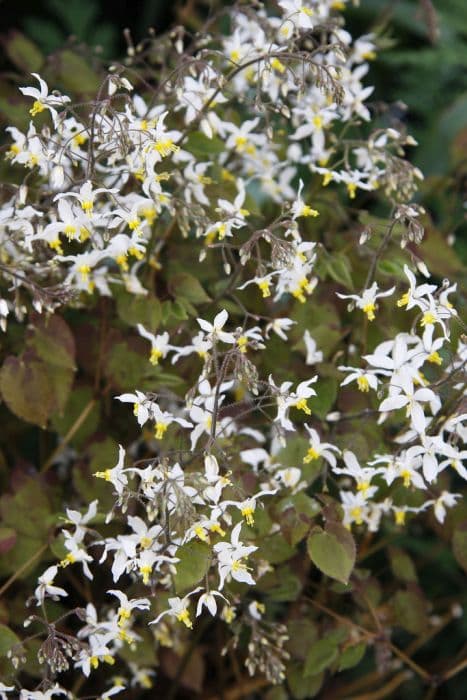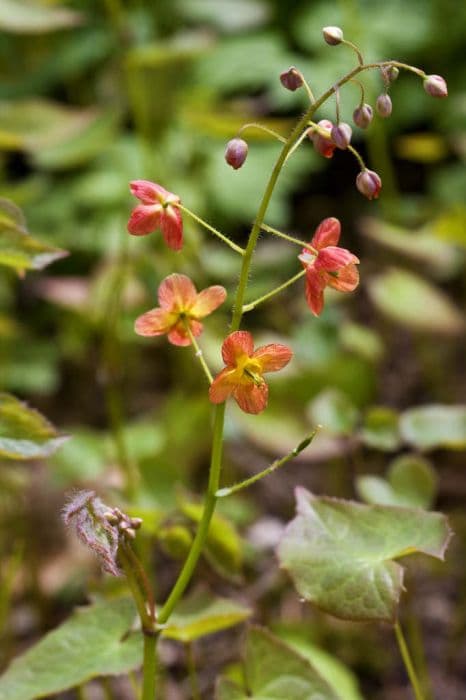Franchet's Barberry Berberis dictyophylla

ABOUT
The plant in question, commonly known as the Berberis dictyophylla, is a visually striking species. Its most notable feature is its foliage, which comes in a variety of shades, ranging from a deep green to a bluish-green tint. The leaves on this plant are small and arranged in a dense, overlapping pattern which can give a scaly appearance. These leaves often have a leathery texture, enhancing the plant's hardy appearance. Come springtime, the plant exhibits small, vibrant yellow flowers. These blossoms contrast beautifully against the more subdued tones of the foliage. The flowers are structured in characteristic small clusters, adding to the ornamental appeal of the plant during its blooming season. As the flowering season concludes, the plant may produce small, oblong berries. These berries typically ripen to a red or purple hue, creating a delightful display against the green backdrop of the leaves. The arresting color combination of foliage, flowers, and fruit can make the Berberis dictyophylla a standout in any landscape where it is found. However, the plant is also known for its thorns, which can be quite sharp and serve as a deterrent to various animals and humans alike, in terms of handling. The overall impression of Berberis dictyophylla is one of rugged beauty, with its richly colored leaves, eye-catching flowers, and berries, as well as its spiny defense mechanisms. This combination of features gives the plant a unique charm that can enhance various natural settings.
About this plant
 Names
NamesFamily
Berberidaceae
Synonyms
Franchet's Barberry
Common names
Berberis dictyophylla.
 Toxicity
ToxicityTo humans
Berberis dictyophylla, commonly known as Barberry, contains alkaloids such as berberine, which can be toxic to humans if ingested in large quantities. Symptoms of Barberry poisoning may include nausea, vomiting, diarrhea, abdominal pain, dizziness, and in severe cases, respiratory failure and convulsions. Long-term consumption may lead to kidney damage.
To pets
Barberry is also toxic to pets due to the presence of alkaloids such as berberine. If a pet ingests Barberry, they may experience symptoms similar to those in humans, including vomiting, diarrhea, lethargy, and possibly more severe symptoms like difficulty breathing or tremors in cases of significant ingestion. Long-term or repeat exposure can potentially lead to liver or kidney issues. Immediate veterinary attention is advised if a pet has consumed any part of the plant.
 Characteristics
CharacteristicsLife cycle
Perennials
Foliage type
Evergreen
Color of leaves
Green
Flower color
Yellow
Height
4 feet (1.22 meters)
Spread
4 feet (1.22 meters)
Plant type
Shrub
Hardiness zones
7
Native area
China
Benefits
 General Benefits
General Benefits- Landscape Design: Berberis dictyophylla, commonly known as barberry, is often used for landscaping due to its attractive foliage and vibrant berries which add color and texture to gardens.
- Drought Resistance: This plant is known for its ability to withstand dry conditions, making it suitable for xeriscaping and gardens in arid climates.
- Erosion Control: The root system of barberry helps stabilize soil and prevent erosion on slopes and hillsides.
- Low Maintenance: Barberry requires minimal care once established, making it a convenient choice for busy gardeners.
- Habitat for Wildlife: The berries provide food for birds, and the dense foliage offers shelter for various wildlife species.
- Thorny Defense: The thorns on barberry bushes can act as a natural deterrent against trespassing animals and unauthorized human access.
- Year-Round Interest: Barberry offers visual interest throughout the year with its changing leaf colors and persistent berries in colder months.
- Tolerance to Pollution: Barberry is fairly tolerant of urban pollution, making it a good choice for city landscapes.
- Variety of Uses: Beyond ornamental use, barberry can be used in hedges, as foundation plants, or in mixed shrub borders for structure and color contrast.
- Cold Hardy: Barberry is capable of surviving in cooler climates, which makes it a versatile addition to a variety of geographic locations.
 Medical Properties
Medical PropertiesThis plant is not used for medical purposes.
 Air-purifying Qualities
Air-purifying QualitiesThis plant is not specifically known for air purifying qualities.
 Other Uses
Other Uses- Berberis dictyophylla, known as Barberry, can be used for dyeing textiles; the roots and bark produce a yellow dye.
- The spiny branches of Barberry can be incorporated into garden boundary hedges as a deterrent against intruders.
- Barberry's dense and prickly characteristics make it suitable for sheltering small birds and providing nesting sites.
- The bright red berries of the Barberry can be used to make jellies and preserves.
- Barberry can serve as an ornamental feature in gardens due to its attractive foliage and berry displays.
- The wood of Barberry can be used for crafting small objects such as tool handles, due to its hardness.
- In some cultures, Barberry is used in traditional ceremonies and decorations.
- Barberry bushes are sometimes planted for erosion control because their root system helps to stabilize soil.
- The berries can be used as a natural food coloring agent.
- Landscapers may use Barberry in xeriscaping designs due to its drought tolerance once established.
Interesting Facts
 Feng Shui
Feng ShuiBerberis dictyophylla is not used in Feng Shui practice.
 Zodiac Sign Compitability
Zodiac Sign CompitabilityBerberis dictyophylla is not used in astrology practice.
 Plant Symbolism
Plant Symbolism- Protection: Berberis dictyophylla, or Barberry, is often associated with protection due to its thorny branches, which can serve as a physical barrier against unwanted animals and negative energies.
- Purification: Barberry have been used historically in herbal medicine to cleanse the body and blood, hence it symbolizes purification and detoxification.
- Adaptability: The ability of Barberry to adapt to different soil types and environmental conditions makes it a symbol of adaptability and resilience.
- Sharpness: The sharp thorns of Barberry can represent acuity in both perception and intellect, resembling the need for sharp thinking or a clear mind.
- Patience: The plant's growth process requires patience, and as such, it can symbolize the importance of patience in overcoming difficulties.
 Water
WaterThe Himalayan barberry should be watered thoroughly and then allowed to dry out somewhat between waterings. Generally, the plant prefers slightly moist soil, so you might find yourself watering it approximately once every week, though this can vary depending on the climate and soil conditions. It's important not to overwater as this can lead to root rot. In terms of amount, each watering should be deep enough to soak the root zone, which might mean using about 1 to 2 gallons for an established plant in a garden setting, adjusting for rainfall and current soil moisture levels.
 Light
LightHimalayan barberry thrives best in full sun to partial shade. An ideal spot would provide at least six hours of sunlight per day, which would ensure healthy growth and flowering. However, in extremely hot climates, some afternoon shade can be beneficial to prevent scorching. The plant is versatile and can adapt to different lighting conditions, but the brightest possible light within its tolerance range would yield the best results.
 Temperature
TemperatureHimalayan barberry is fairly cold-hardy and can tolerate temperatures down to around 0 degrees Fahrenheit. The ideal temperature range for this plant falls between 60 and 70 degrees Fahrenheit during the growing season, but it is quite adaptable and can handle fluctuations beyond this range. As for heat, the plant generally can cope with temperatures up to about 95 degrees Fahrenheit, but at the higher end, providing some shade and extra water can be beneficial.
 Pruning
PruningPruning Himalayan barberry is often done to maintain shape, encourage airflow, and remove any dead or diseased branches. The best time to prune is late winter to early spring before new growth begins. It’s not necessary to prune this plant every year, but a light pruning every couple of years can help to rejuvenate the plant and keep it looking tidy.
 Cleaning
CleaningAs needed
 Soil
SoilFor Barberry, a well-draining soil mix is essential with a pH around 6.0-7.0. A mix of loam, peat, and sharp sand in equal parts can provide the necessary drainage and aeration.
 Repotting
RepottingBarberry plants need to be repotted every 2-3 years to prevent root-bound conditions and to refresh the soil.
 Humidity & Misting
Humidity & MistingBarberry prefers average to low humidity levels and can tolerate some dry air, making it suitable for most home environments.
 Suitable locations
Suitable locationsIndoor
Place Barberry near a sunny window and ensure good air flow.
Outdoor
Plant Barberry in a sunny spot with well-draining soil and space for growth.
Hardiness zone
5-8 USDA
 Life cycle
Life cycleBerberis dictyophylla, commonly known as Dictyophyllous Barberry, begins its life cycle with seed germination, which occurs under favorable temperature and moisture conditions in spring. The seedlings emerge and grow into young plants with characteristic spiny leaves and a strong root system. As the plant matures, it develops woody stems and reaches reproductive maturity, producing clusters of yellow flowers that are typically pollinated by insects. Following pollination, the flowers develop into small, oblong red berries that contain seeds, allowing for the dispersal and continuation of the species. Over time, the plant may experience a period of dormancy during colder months and rejuvenates its growth come spring. Throughout its lifetime, Dictyophyllous Barberry can also spread vegetatively through root suckers, forming thickets and expanding its presence in an area.
 Propogation
PropogationPropogation time
Spring to Summer
The most popular method for propagating Berberis dictyophylla, commonly known as the barberry, involves using semi-hardwood cuttings. This technique is typically done in late summer. The process begins by selecting healthy, disease-free branches and cutting them into lengths of 4 to 6 inches (about 10 to 15 centimeters). Each cutting should have several leaf nodes, and the leaves on the lower half should be carefully removed. The cut end is then dipped in rooting hormone to encourage root development. The prepared cuttings are planted in a well-draining propagation medium, such as a mix of peat and perlite, and kept under conditions of high humidity and indirect light. With proper care, the cuttings will root in several weeks, after which they can be gradually acclimatized to less controlled conditions before being planted in their permanent location.









